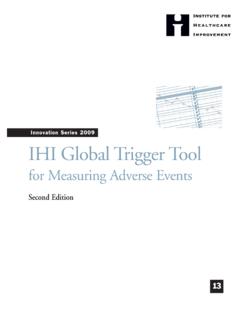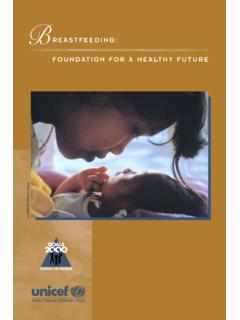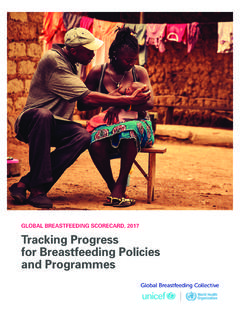Transcription of A User’s Guide to Documentation and Data Collection of the ...
1 A User s Guide to Documentation and data Collection of the Ten Steps to Successful Breastfeeding Emily C. Taylor, MPH, IHI-IA, LCCE, CD(DONA) Founder and Director of WISE Edited by Emily Bernard, BSPsy, IBCLC 2013, Updated August, 2016 Users Guide to Documentation and data Collection of The Ten Steps Page 1 Women-Inspired Systems Enrichment 2013, Updated 2015 Introduction Effective Documentation , data Collection and analysis are critical to any quality improvement effort. This User s Guide is intended to support optimal practices for hospitals participating in the baby - friendly Hospital Initiative or implementing a quality improvement initiative for maternity care practices. It is designed to ease your transition to a newer set of Documentation norms that better-reflect current standards of practice in maternity care.
2 This document: 1. Describes a set of measures designed to align with the Joint Commission Perinatal Core Measure 051 and baby - friendly USA requirements;2 2. Outlines several options for documenting each measure using standard selection tools that can easily be extracted for reports, and; 3. Summarizes recommendations for simple data Collection and analysis of each measure. The Gold Standard: The Electronic Health Record The Electronic Health Record (EHR) is considered the gold standard in Documentation for s reasons: 1. Research shows that well-designed Documentation requirements often drive care practices, especially when staff are experiencing changes to their workflow. For example, requiring the nurse to check off the elements of patient education in the EHR cues the nurse to provide the information, ensuring comprehensive care and preventing oversights.
3 Since EHRs are tailored primarily to clinical work flows; information is often captured as narrative Documentation . Differences in writing style, as well as desire to accurately record clinical details or degree of confidence in observations, lead to wide variations in clinicians' expression of a given fact, making automated interpretation difficult. 3 Take for instance, Irene, a quality improvement advisor at a large teaching hospital who wanted to report on rates of instruction about feeding cues. Feeding cues were recorded in nurse progress notes using free text, so Irene had to search for the information. Nurses were using different words: cue, on-demand, baby -led, etc., which made it difficult to find. Furthermore, some nurses told her that they often forgot to document the instruction even if they did it.
4 After making Feeding Cues a checkbox option in the patient education tab, Irene could auto-generate a report that showed how many mothers did have the feeding cues box checked. She still interviewed a sample of patients to ensure that they understood the instruction, but she now had census-level data with which to drive improvement efforts and hold staff accountable. She praised the staff for the improvement she saw in the EHR and heard about during patient interviews. The staff replied that it was much easier to remember when it was part of their standard teaching checklist. 1 2 3 Users Guide to Documentation and data Collection of The Ten Steps Page 2 Women-Inspired Systems Enrichment 2013, Updated 2015 2.
5 Automating data Collection , which is only possible in the EHR, will make it faster and easier for you to learn from your data . Yes, it can be challenging to add or change the EHR. However once complete, an EHR professional will be able to compile the information needed to track progress over time quickly and efficiently. This allows for more time to be spent on the real improvement work. The control chart pictured in Figure 1 demonstrates best practice in a visual display of data . It pulls data on all post-partum patients from September 0f 2013 through September of 2014. In a few seconds, one can see rates of instruction about manual milk expression appeared to be rising for the first few months while data was being collected through patient interviews with a small sample of patients.
6 However, the facility added Documentation to the EHR at the end of November, 2013, and the practice actually appeared to decrease. This may have been a real practice change, or more likely, a reflection of the time it can take for staff to begin using the EHR Documentation consistently and accurately. Within two months, the practice was back to the same median as before the Documentation change, suggesting that their real practice was about 20%. In March, 2014, the IBCLC shifted some of the time she previously spent conducting patient interviews to facilitate a Nursing Hand Expression Competency Fair, after which rates of instruction rose significantly and continuously. The team can see their progress, tell their story, and make informed decisions about how to continue improving this priority practice.
7 This illustrates a productive, meaningful use of data from the EHR. UCLLCL0102030405060708090100 Figure 1. Manual Milk Expression InstructionUrban Hospital, 9/2013 -9/2014 Documentationadded to EHRN ursing Hand Expression Competency Fair I used to spend tons of time conducting chart audits searching through nursing and provider notes to see whether each practice was done. Now, I get an automated report from IT each month, including rates of each practice for ALL births. It took about two months for everyone to get used to checking the new boxes. Still, the results from the full census matches the results I get from patient interviews much better than the audits I used to do. I can spend more time with patients, and the quality of the data is more dependable!
8 Kim Mother- baby Nurse Users Guide to Documentation and data Collection of The Ten Steps Page 3 Women-Inspired Systems Enrichment 2013, Updated 2015 3. The well-organized EHR is known to increase consistency and communication among the many health professionals responsible for caring for mothers and babies. This results in fewer omissions and errors, improved efficiency, and greater patient satisfaction. Meaningful Use Meaningful use has become a hot topic in contemporary healthcare systems. According to the United States Government,4 the concept of meaningful use rests on the five pillars of health outcomes policy priorities, namely: 1. Improving quality, safety, efficiency, and reducing health disparities 2.
9 Engage patients and families in their health 3. Improve care coordination 4. Improve population and public health 5. Ensure adequate privacy and security protection for personal health information Electronic Health Records enable us to compile massive amounts of clinical data , driving the process of change. The expansion of machine-readable health information provides new opportunities for quality The trick is to document what is actually needed (nothing more and nothing less) to: a) ensure safe patient care, and b) allow efficient data gathering to aid in the improvement process. When we learn from our compilation of data , informed decisions about how to manage our quality improvement programs can be made. Using Your data to Learn and Drive Improvement Once you have the Documentation system you need to auto-generate regular reports, it is best to do so at least monthly since you are looking at fairly common events.
10 You can even create visual displays of your data , and post it for staff and patients to see, making everyone a part of the improvement journey. It is best to compare your EHR data with patient interviews, point-of-use inventory management programs (such as Pyxis) and other data sources. Doing so will provide additional information to use in deciding where to direct your improvement efforts and create a verification loop. For example, you may wish to know how your feeding cues instruction is progressing. The EHR consistently reflects 95-100% rate of instruction. Using the baby friendly USA Post-Partum Woman Audit Tool, you ask a sample of moms, What have you been told about how often and how long to feed 4 5 I always know which topics have already been discussed with my patient because they are setup like a checklist in the EHR.














